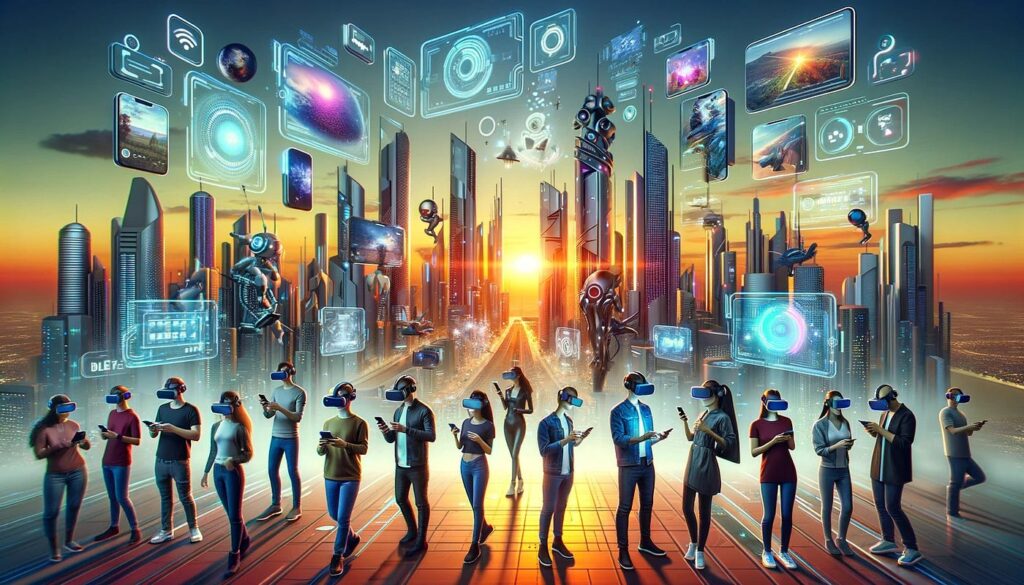By 2025, the rapidly growing virtual reality gaming industry will reach $100 billion. Improvements in metaverse and cloud-based gaming is empowering VR to be more interactive and engaging. With over 50 million active VR players around the world, the Gaming Sector is shifting toward massive video game play and AI-driven storytelling. Let us get to the nitty-gritty of how VR gaming is changing the whole landscape of gaming industry in 2025.
Next Level Virtual Reality Technology: More Immersive Than Before!
Leading brands including Meta, Sony, and HTC have launched high-definition VR headsets with 4K images; 120Hz refresh rates, and real eye tracking. Sophisticated gaming experiences are more frequent in the international VR headset industry, which grows yearly by 30 percent per year.
Non-Player Characters and Gaming:
By enabling sophisticated non-payer characters that react to player activity, artificial intelligence is changing virtual reality video games. In 2025, 60% of fresh VR titles provide custom and unusual play as well as artificial intelligence created environments.
Also, AI-driven characters develop from player contacts and so give realistic gaming experiences. Accessibility will be achievable via cloud gaming and virtual reality broadcasting.
Cloud-based VR gaming allows players play using expensive devices and immediately share games. By 2025, 40% of VR users would be using 5G and AI-enabled rendering supported cloud gaming services. This will allow outstanding VR gaming on independent headsets, smart TVs, and mobile phones.
Social Virtual Reality: The Rise of Metaverse Gaming!
Artificial intelligence is transforming virtual reality video games by assisting clever non-player characters that respond to player actions. Sixty percent of cases of new virtual reality games in 2025 feature custom and erratic play in artificial surroundings. AIdriven personalities pick up from player activities, hence producing realistic gaming encounters.
Virtual Reality Broadcasting And Cloud Gaming Will Provide Access:
VR gaming in the cloud-based gaming helps to share games on the spot and eliminate the need of costly equipment. Therefore enabling excellent VR gaming on mobile phones, smart TVs, and standalone headsets by 2025, 40 percent of VR players will use 5G and AI-driven rendering powered cloud gaming services.
Haptic Feedback And Sensory Integration:
Haptic feedback technology is among the most revolutionary developments in virtual reality gaming. Players will be able to physically sense texture, weight, and environmental resistance using VR gloves, suits, and even full body tracking systems by 2025. Wearable technology from companies such as HaptX and Tesla Suit transmit lifelike vibrations and force feedback to imitate actual senses. Not only are these technologies making VR gaming more realistic, but they are also creating opportunities for virtual sports, rehabilitation, and military training simulations.
Besides touch, virtual reality gaming is also incorporating sophisticated auditory and olfactory (smell based) technology in 2025. High-quality headsets have spatial 3D sound that lets gamers pick out motion and directionality very precisely. Experimental scent-based VR devices also add another level of realism to VR interactions by releasing particular scents based on in game settings.
AI Personalized Narratives:
Games development and playing are being transformed by AI-driven procedural content generation. VR Gaming encounters by 2025 are dynamic; they develop in real time depending on a person’s behavior, choices, and preferences. Sophisticated machine learning models analyze player behavior to generate customized game stories with limitless options.
AI creates whole worlds on the fly, customizing every game session and letting players choose their own levels. Picture yourself in an open world VR RPG where terrain, personalities, and missions are spontaneously created based on your environmental interaction. This level of flexibility guarantees that every player has a unique experience, significantly enhancing the replay ability of games.

BCIs: The Next Frontier of Gaming!
Another big development in VR gaming is seen in brain computer interfaces. Next Mind and Neuralink among other businesses are developing direct neural input systems that let gamers control in game actions simply by thinking.
Early adopters of BCI technology will be able to interact with digital worlds in previously never-observed ways like physically moving stuff, casting spells, or perhaps interacting with in game characters via neural commands alone by 2025.
Although fully mind controlled VR gaming is still in its early stages, hybrid systems using traditional motion tracking and haptic feedback combined with BCIs are becoming more popular. Accessibility is particularly aided by this technology since it lets game players with physical handicaps experience gaming in a way previously not possible.
Cross-Platform, Hybrid Reality Play:
The rise of mixed reality (MR) is going still further to blur the distinction between actual and virtual environments. VR games will allow people to combine their real world with computerized gaming by 2025 as they use more and more augmented reality (AR) components. Picture yourself in a post-apocalyptic battlefield in an action adventure VR game or in an RPG where virtual characters interact with actual items.
Hybrid gaming experiences are also enabling VR and non-VR players to play across devices. Multiplayer VR games can now bring together traditional PC, console, and mobile players into the same virtual world, thereby making the gaming community more connected and inclusive.
Ethical and Psychological Concerns:
Worries about how virtual reality gaming will affect mental health, dependency, and digital health are emerging as the technology improves. By 2025, responsible gaming features including built-in A powered monitoring systems to identify too much playtime, remind players to take breaks, and vary level of difficulty based on player fatigue will be developed by researchers and game developers in close partnership. Developers are also using ethical artificial intelligence models to guarantee that interactive experiences do not cause sensitivity or psychiatric problems.
Conclusion:
Finally, by means of developments in artificial intelligence, haptic feedback, brain computer interfaces, and mixed reality, the 2025 VR gaming scene is a fast changing one. These developments are turning gaming into more than simply entertainment; it is a means of social interaction, learning, training, and even therapy. Next Gen VR Gaming will reshape the way we engage with virtual worlds as technology keeps on testing the limits of immersion and realism.

